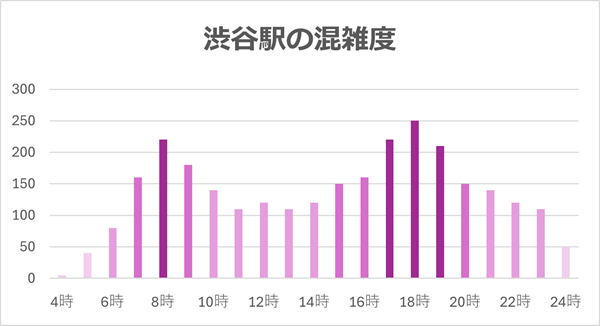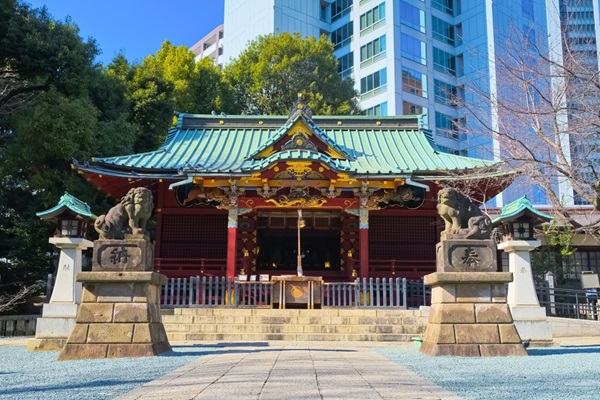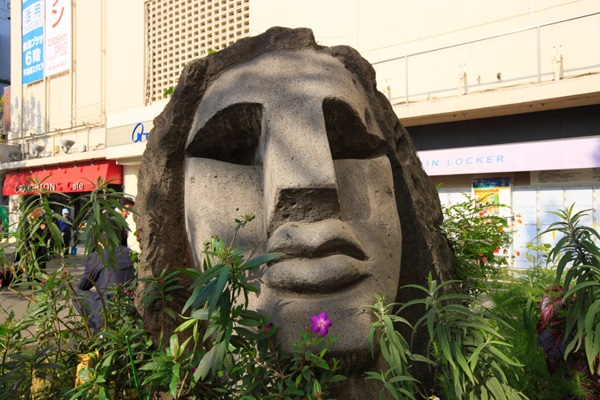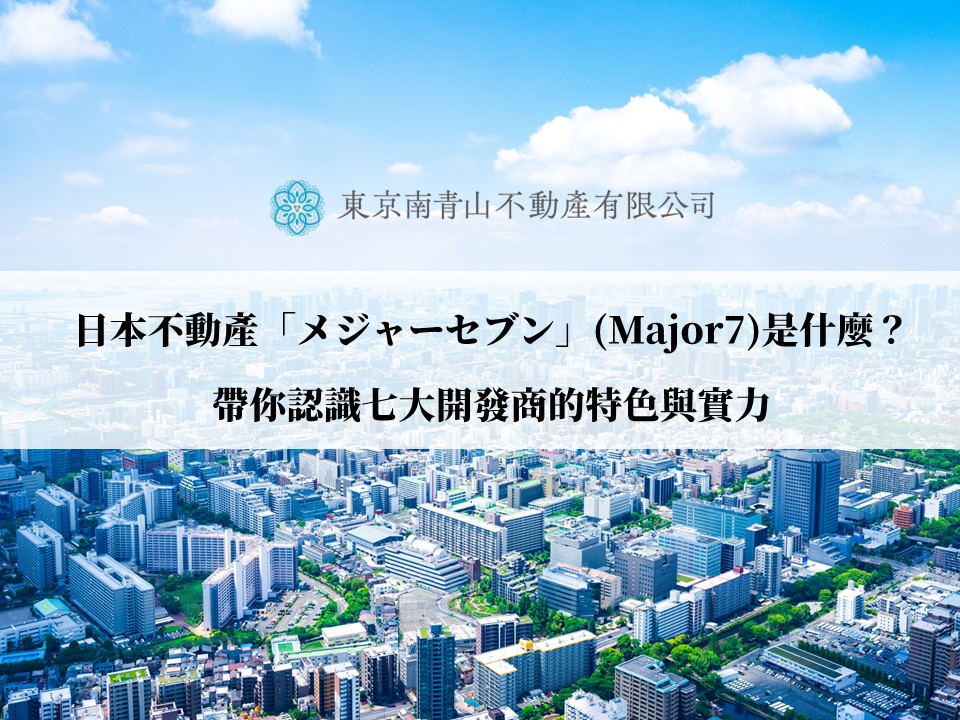Shibuya is Tokyo's representative downtown area and is also known as the epicenter of youth culture. Shibuya Station, located in the center of the area, is one of the busiest stations in Japan.
Shibuya Station is now a place where many people come and go every day, but when it first opened about 140 years ago, it had a completely different face.
We will introduce the charm of Shibuya Station and its surrounding area, which continues to change significantly with the times, along with its past history and future prospects.

Basic information about Shibuya Station, the epicenter of youth culture
Shibuya Station is located in Shibuya Ward, one of Tokyo's most popular and lively areas, especially among young people.
After Shibuya Station opened in 1885, multiple lines began passing through, and the area around the station rapidly developed from the Meiji to Showa periods. From the Showa era to the Heisei era, fashion buildings such as SHIBUYA 109 and Shibuya PARCO, and large CD shops such as Tower Records and HMV were born, and Shibuya became a trend center for young people. The term "Shibuya-kei" was coined in the early Heisei era. The culture born in Shibuya has started to attract attention all over the world.
In addition, there is the famous scramble crossing and Hachiko statue in front of the station, which attracts many foreign tourists in addition to young people every day.
According to data on the number of passengers getting on and off by station released by the Ministry of Land, Infrastructure, Transport and Tourism in 2022, the average number of passengers getting on and off at Shibuya Station in 2021 was 497,010 people per day, making it the fifth-highest station in JR East.
Source: Ministry of Land, Infrastructure, Transport and Tourism National Land Numerical Information Download Site “ Data on the number of passengers getting on and off by station ”
Source: Statistical Information Research “ Statistics on the number of passengers getting on and off at Shibuya Station (JR East) ”
The congestion level at Shibuya Station per weekday is as follows.

*Created independently by processing from JR East official website “Station congestion situation” and NAVITIME “Crowd forecast”
*Classified into four levels of congestion based on the numbers on the vertical axis. Very crowded (200-250), crowded (150-200), not very crowded (100-150), empty (0-100)
There are many restaurants and commercial facilities around Shibuya Station, and many people, especially young people, gather there. As a result, it tends to be crowded during lunch hours on weekdays, especially on weekends and holidays. In addition, many tourists come and go around the scramble crossing, both weekdays and weekends.
There are many restaurants and commercial facilities around Shibuya Station, and many people, especially young people, gather there. As a result, it tends to be crowded during lunch hours on weekdays, especially on weekends and holidays. In addition, many tourists come and go around the scramble crossing, both weekdays and weekends.
JR East
Saikyo Line/Kawagoe Line
Shonan Shinjuku Line
Yamanote Line
Narita Express
Direct connection to Sotetsu Line
Subway (Tokyo Metro)
Ginza line
Hanzomon Line
Fukutoshin Line
Private railway
Keio Inokashira Line
Tokyu Toyoko Line
Tokyu Denentoshi Line
If you use these lines, you can go in a straight line to Asakusa and Oshiage (Tokyo) to the east, Kichijoji (Tokyo) to the west, Yokohama (Kanagawa Prefecture) to the south, and Utsunomiya (Tochigi Prefecture) and Takasaki (Gunma Prefecture) to the north. You can access it.
Ebisu Station and Omotesando Station are also within a 15-minute walk from Shibuya Station. Another point is that it is easy to use the Tokyo Metro Hibiya Line and Chiyoda Line, which do not connect to Shibuya Station.
There is also a bus rotary in front of Shibuya Station, and many local buses also run there. Route buses depart from Shinbashi Station, Roppongi Hills, Takanawa Gateway Station, Gotanda Station, Osaki Station, etc.
JR East Saikyo Line/Kawagoe Line Shonan Shinjuku Line Yamanote Line Narita Express Direct connection to Sotetsu Line Subway (Tokyo Metro) Ginza line Hanzomon Line Fukutoshin Line Private railway Keio Inokashira Line Tokyu Toyoko Line Tokyu Denentoshi Line If you use these lines, you can go in a straight line to Asakusa and Oshiage (Tokyo) to the east, Kichijoji (Tokyo) to the west, Yokohama (Kanagawa Prefecture) to the south, and Utsunomiya (Tochigi Prefecture) and Takasaki (Gunma Prefecture) to the north. You can access it. Ebisu Station and Omotesando Station are also within a 15-minute walk from Shibuya Station. Another point is that it is easy to use the Tokyo Metro Hibiya Line and Chiyoda Line, which do not connect to Shibuya Station. There is also a bus rotary in front of Shibuya Station, and many local buses also run there. Route buses depart from Shinbashi Station, Roppongi Hills, Takanawa Gateway Station, Gotanda Station, Osaki Station, etc.
We will introduce the main access methods and travel times from Shibuya Station to major stations and airports in Tokyo.
Tokyo Station: 11 stations on the JR Yamanote Line (outer loop)
Shinjuku Station: 1 station on the JR Saikyo Line or JR Shonan-Shinjuku Line (approx. 5 minutes)
Ikebukuro Station: 2 stations on the JR Saikyo Line or JR Shonan-Shinjuku Line (about 15 minutes)
Haneda Airport (Terminal 2): Transfer at Hamamatsucho Station on the JR Yamanote Line (inner loop) and take the Tokyo Monorail (toward Haneda Airport/Airport Rapid) for 3 stops (Haneda Airport Terminal 2 Station)
Narita Airport (Terminal 1): 4 stops on the Narita Express (limited express for Narita Airport) (Narita Airport Station)
Sightseeing spots that can be accessed directly from Shibuya Station
From Shibuya Station, you can take the Limited Express Odoriko (*) to Atami, Ito in Shizuoka, Izu Kogen, and Kawazu.
*Stops at Shibuya Station only on Saturdays, Sundays, and holidays.
Additionally, if you use the conventional lines that connect to Shibuya Station, you can access the following sightseeing spots without changing trains.
Kichijoji (Inokashira Line)
Kawagoe (Fukutoshin Line direct to Tobu Tojo Line, Saikyo Line direct to Kawagoe Line)
Kamakura (Shonan Shinjuku Line)
Utsunomiya (Shonan Shinjuku Line)
Yokohama (Shonan-Shinjuku Line, Toyoko Line)
Minato Mirai, Motomachi/Chinatown (Toyoko Line direct Minato Mirai Line)
In addition, express buses depart from Shibuya Mark City to Karuizawa, Kusatsu Onsen, Sendai, Kanazawa, Kyoto, Osaka, Kobe, etc., making it convenient for sightseeing.
Culture originating from Shibuya has an influence that is transmitted to the world
Around Shibuya Station, there are many high-rise buildings constructed in recent years through redevelopment, such as Shibuya Hikarie, Shibuya Scramble Square, and Shibuya Mark City. It has the face of an international city, with an abundance of facilities that support various lifestyles such as fashion, culture, and gourmet food.
There are many popular cafes and sweets shops around the station, and one of the benefits of living near Shibuya Station is that you can get up to speed on trends. There are many convenience stores and drugstores, so you can find everything you need for daily life near the station, which is one of the comforts of living here.
In addition to trains and route buses, the community bus ``Hachiko Bus'' that runs around Shibuya Ward centering on Shibuya Station also runs regularly, making the area very convenient for transportation.
Furthermore, the area around Shibuya Station is characterized by its strong international flavor. As of January 2024, there are 11,935 foreigners living in Shibuya Ward. The reason for the large number of foreign residents is thought to be that there are many foreigners working in the Shibuya area, as there are many embassies and foreign companies in Shibuya Ward.
In the past, unique fashion culture from Shibuya such as ``Ganguro'' and ``Yamamba'' was transmitted to the world. The same is true today in the Reiwa era, and from Shibuya, where various fashion buildings are gathered, new cultures such as fashion and music, especially for young people in their teens and twenties, are being born one after another and are spreading to the world.
Another attractive feature is that it is easy to walk from Shibuya to fashionable towns that are featured in fashion magazines, such as Harajuku, Yoyogi-Uehara, Omotesando, Ebisu, and Daikanyama.
This is probably why it is an attractive place to live for people from all over the world.
Shibuya Station has developed from a station with few users to a hub of Tokyo
Shibuya Station opened in 1885 as a station on the Shinagawa Line of Japan Railway. At first, there were about a dozen users per day, which is hard to imagine from today's Shibuya Station. The reason there were so few users is probably because the area around Shibuya Station is surrounded by fields and there are few residents.
It was in 1909 that Shibuya began to undergo a transformation. With the electrification of railways, the Shinagawa Line was reborn as the Yamanote Line, and Shibuya Station grew into a transportation hub. In the 1920s, Shibuya Station was moved due to the elevation of the Yamanote Line, and since then, lines have opened one after another.
As new lines entered the area, the area around the station developed significantly, and the Toyoko Department Store opened in 1934 (closed in 2020). This was a representative station building that housed Japan's first famous shopping street, Toyoko Norengai, and the Tokyu Food Show, which sparked the underground boom in department stores. In addition, in the 1970s, the fashion building "SHIBUYA109", which can be said to be a symbol of Shibuya, was born, and in the 2000s, "Shibuya Mark City", a commercial facility directly connected to the station, was born. Even after entering the Reiwa era, new high-rise buildings are being constructed one after another around stations.
In 2023, Shibuya Sakura Stage, a complex facility with an emphasis on digital and sustainability, will open. Tokyu Group, which is involved in the redevelopment of Shibuya, aims to create a "Shibuya-style urban lifestyle" that combines the three elements of "work, play, and life"
In this way, Shibuya Station and its surrounding area are not just the starting and ending points of travel but can also be described as a symbol of Tokyo's world-class dynamism. Shibuya Station has always been at the cutting edge of the times, from its opening to the present and into the future. Its evolution is like an adventure that transcends time and space. More detailed changes in the Shibuya Station area are introduced in " SHIBUA CITY RECORD " published by Shibuya Ward.
Spots around Shibuya Station where you can feel the culture and history of Shibuya
Shibuya, a vibrant and vibrant city that is the center of Japanese fashion and culture trends, is dotted with a variety of attractions. We will introduce spots that will make Shibuya even more attractive - from the cutting-edge to the historic, to the ones where you can enjoy the fusion of new things while valuing history.
Shibuya Hikarie, a commercial complex with a theater
Shibuya Hikarie, which opened in 2012, is a high-rise complex that has a variety of functions including offices, commercial facilities, and a theater, and creates active communication between people, goods, and information.
Tokyu Theater Orb, a large-scale theater located on the 11th floor, is characterized by its flexibility in the installation of lighting and equipment, allowing it to accommodate a variety of productions. The stage is close to the audience seats, making the musical more moving.
In addition, restaurants from around the world, including Japanese cuisine such as sushi and eel, as well as Chinese, Korean, and Italian cuisine, will be gathered, and there will be a variety of cafes and restaurants that can be used for lunch or dinner regardless of time.
Shibuya Hikarie official website
Kinno Hachimangu Shrine, a power spot located in the city of Shibuya

Konno Hachimangu Shrine is located on the east side of Shibuya Station. It is a shrine with a long history that was established in Shibuya in 1092. It is said to bring good luck, ward off evil spirits, and bring good luck, and in some rare places it is worshiped as the ``God of travel safety.''
The main building of Kinno Hachimangu Shrine is a Gongen-zukuri style (*) that has remained unchanged since the Edo period and is one of the most valuable buildings in Tokyo. While the overall design is luxurious, there are delicate carvings throughout. Particularly distinctive is the carvings of tapirs and tigers on the left and right sides of the front of the shrine. The tapir symbolizes a prayer for ``peace of the world,'' and the tiger symbolizes a prayer for ``correct festivals.''
*An architectural style in which the main shrine and worship hall are connected by a stone hall (or a stone hall).
In addition, the rare ``Kinnozakura'', which blooms with a mixture of single and double cherry blossoms on one branch, is planted within the precincts. During the Edo period, it was counted as one of the three famous cherry blossoms of Edo. In spring, it is a cherry blossom viewing spot that is enjoyed by many people.
Kinno Hachiman Shrine official website
Shirane Memorial Shibuya Folk Museum and Literature Museum, a facility where you can learn about the history of Shibuya
The Shirane Memorial Shibuya Folk Museum and Literary Museum has exhibits on the themes of Shibuya's history, folklore, and archeology. This is a valuable facility where you can experience the changes in Shibuya from the Paleolithic era to the present day. Earthenware found in the Shibuya area and a reproduction of the interior of a house in the Shibuya area from the Showa era are on display.
Based on the concept of "get to know SHIBUYA casually", the entrance fee is 100 yen (50 yen for elementary and junior high school students), making it a place where you can easily stop by (as of March 2024).
Shirane Memorial Shibuya Folk Museum and Literature Museum Official Website
"MIYASHITA PARK" where a park and commercial facility are integrated

MIYASHITA PARK is a low-rise complex with a total length of approximately 330m located on the east side of Shibuya Station.
"Shibuya Miyashita Park" has been relocated to the rooftop, "RAYARD MIYASHITA PARK" is the first commercial facility in Shibuya Ward to utilize the three-dimensional city park system (*), and "sequence MIYASHITA PARK" is a hotel located in the northern part of the site. It consists of
*A system that allows for the integrated development of other facilities and city parks to make effective use of land.
You can feel the natural breeze and greenery from the entire commercial facility surrounded by a green canopy. RAYARD MIYASHITA PARK is home to approximately 90 shops, including 7 stores opening in Japan for the first time and 32 stores opening for the first time in a commercial facility.
It is easily accessible from Shibuya Station and is a spot that many people visit every day, as it can be used not only for eating, cafes, and shopping, but also as a place to relax.
MIYASHITA PARK official website
Trivia about meeting spots at Shibuya Station
Trivia about meeting spots at Shibuya Station
The Hachiko statue in front of Shibuya Station is actually the second generation!

Did you know that the Hachiko statue in front of Shibuya Station is the second one?
The first Hachiko statue was installed in 1934, and it is said that Hachiko himself, who was still alive at the time, attended the unveiling ceremony.
However, due to resource shortages during World War II, the first Hachiko statue was designated for metal collection in 1944 and was donated.
After the war, calls for the restoration of the Hachiko statue grew, and in 1948, the second Hachiko statue was rebuilt at the same location. The person who created the second Hachiko was the eldest son of Teru Ando, who created the first Hachiko. The first Hachiko statue and the second Hachiko, who inherited his father's wishes, still watch over many people in front of Shibuya Station.
The secret of "Moai Statue" at Shibuya Station

When it comes to meeting spots at Shibuya Station, not only the Hachiko statue but also the Moyai statue at the west exit are famous. A Moai statue is a statue that is modeled after the Moai statue on Easter Island.
The Moai statue in Shibuya was donated to Shibuya Ward from Niijima Village in 1980. The name "Moyai" not only comes from the Moai statues on Easter Island, but also comes from the words "moyau", which means to tie a ship with a rope, and "soai, haiai", which means to help each other. It also has meanings such as
By the way, this Moyai statue was given to Niijima Village to commemorate the 100th anniversary of its transfer to Tokyo, but why is it in Shibuya Ward? It is said that the purpose of this was to further deepen exchanges between Shibuya Ward and Niijima Village, as the Shibuya Ward Youth Center (closed in 2019) is in Niijima Village.
Summary
The Shibuya Station area continues to demonstrate its value as a center of youth fashion and culture. In recent years, high-rise buildings have opened one after another around the station as part of a once-in-a-century redevelopment project, making the area even more convenient for offices, gourmet food, and shopping.
It's a complete change from the days when Shibuya Station was sparsely populated, with many people visiting for sightseeing in addition to commuting to work or school, and it looks like it will continue to be a hotly talked about area. On the other hand, in addition to new buildings, there are also shrines and cultural museums where you can experience Shibuya's history once you step behind the scenes, so the Shibuya Station area has endless charm.
If you are considering purchasing real estate near Shibuya Station, please refer to the convenience of Shibuya Station and the ease of living around the station introduced in this article.











